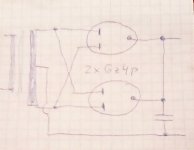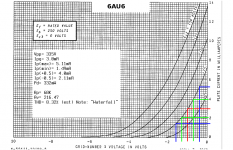Nice! Do you have a schematic out of interest?
Straight forward. No weird stuff.
I think the UF4007s are like the ones in Tubelab designs, to keep the benefits of a delayed start up, but reduce the strain on the rectifier.
Thanks! It was the power supply that I was really interested in since I have some of those regulator tubes.
Straight forward. No weird stuff.
Thanks! It was the power supply that I was really interested in since I have some of those regulator tubes.
The UF4007's provide additional PIV for the rectifier tube on start up. No tube cathode is perfect, and none are perfectly colinear with the surrounding plate. The thinnest part of the cathode coating will reach emission temperature first, and the lowest PIV in the tube will be where the plate is closest to the cathode. On start up all the capacitors in the amp are hungry for a fill up. This is worst case for the rectifier tube. If an arc starts at one or both of the weak links it will continue and intensify when the AC reverses itself applying maximum voltage across the plate-cathode area causing a "spark out" and often damaging or destroying the tube.It appears that either the UF4007's or the 6X4's are superfluous.
Best regards!
The added silicon diode stops the reverse PIV arc before it can do serious damage thus saving the tube. Once the amp is at operating temp the silicon diodes are not in the picture since their constant 0.7 volt drop is dwarfed by the tube's dynamic characteristics and much higher forward drop at peak current.
I added this mod to the Tubelab SSE board back in 2010 when all three manufacturers of new production 5AR4's were having quality problems. The SSE when built for maximum power runs the rectifier pretty hard. Sometimes it took 2 or 3 new 5AR4's to get a good one. The diodes fixed that issue for good.
I have the Bottlehead Quickie battery powered preamp which uses a pair of 3S4 tubes in triode mode. It's a great sounding preamp.
How do you like the MPS Hi-Fi OTs?
I ordered some a while back and they just shipped. I'm planning on using them in a SEP 47 build.
How do you like the MPS Hi-Fi OTs?
I ordered some a while back and they just shipped. I'm planning on using them in a SEP 47 build.
I have built 4 low powered SE amps with them. Very happy with the sound. Nothing to look at cosmetically, but nothing a coat of paint can't fix.
What's the rationale for putting rectifier diodes in series with the plates of the rectifier tube? To save the power xfmr in case the tube shorts out?
Tubelab just answered that question in post #125 above ...What's the rationale for putting rectifier diodes in series with the plates of the rectifier tube? To save the power xfmr in case the tube shorts out?
When I parallel kenotron rectifier tubes I usually cross connect the plates of each tube in an attempt to relieve the strain on the cathodes.
The idea is to have 2 shorter pulses of charging current per cathode per half wave rather than 1 longer and bigger per half wave.
I am not sure whether this is so relevant for 6x4 because plates are stacked along the common cathode sleave such that pulses hit different areas ...
The idea is to have 2 shorter pulses of charging current per cathode per half wave rather than 1 longer and bigger per half wave.
I am not sure whether this is so relevant for 6x4 because plates are stacked along the common cathode sleave such that pulses hit different areas ...
Attachments
The schematics I found with dual rectifiers from the golden age showed the plates tied together. As an amateur, I figured the pros knew what they were doing.
The 6AU6 is a solid workhorse that does just about everything well: CCS, small signal audio amp, RF amp, wideband amp, pseudotriode (with u-Factor that falls nicely between the 6SN7 and 6SL7). The VHK rating is also conveniently high: 200V (heater negative) and 100V (heater positive) that's useful if using it as an active voltage regulator error amp.The 6AU6 hits a sweet spot in specifications which is hard to match in any other small signal pentode. Makes it an excellent candidate for a partial feedback/schade style amp. There are almost no small signal pentodes which can pass reasonable amounts of current like the 6AU6 and its family. Still cheap as chips. Its said to be microphonic - but I have never had one that is.
Shoog
The THD estimate comes in a little large, but that's against the full voltage swing, which you're none too likely to be using anyway. The harmonic profile is the "waterfall" characteristic. I have a whole bunch of these for those reasons.
Attachments
Well, this is interesting. The little amp developed a high pitched whine of about 7-8kHz independent of signal after warming up. The sound was not from the speakers. Tapping the 6AV6 and 6AQ5 tubes with a chopstick did not help. Tapping one of the 6X4WA made the noise go away, only to come back a short while later. I rewired the rectifiers to cross connect the plates, but the noise persisted. I swapped out the tube that was whining, and the replacement also made the noise, though at a lower level. A third tube fixed the problem. Any thoughts on where the noise originated in the tubes? Oh, the 6X4WAs are all NOS GE made in 1979, with 6202 designation etched on the glass.
some pros knew, some didn't ... two examples from the EZ81 parallel rectifier thread:The schematics I found with dual rectifiers from the golden age showed the plates tied together. As an amateur, I figured the pros knew what they were doing.
https://www.diyaudio.com/community/...tte_m40_1962-63_schema_schaltung-jpg.1023537/https://www.diyaudio.com/community/attachments/1644414306092-png.1023559/
Last edited:
- Home
- Amplifiers
- Tubes / Valves
- 7-pin miniature tubes for audio?

